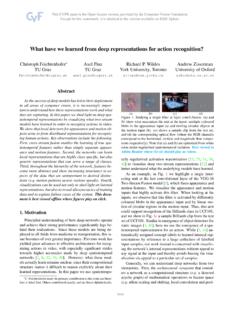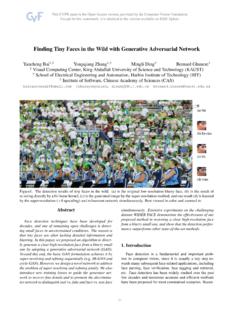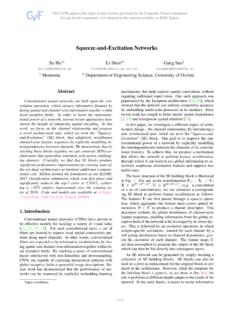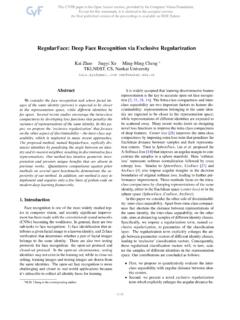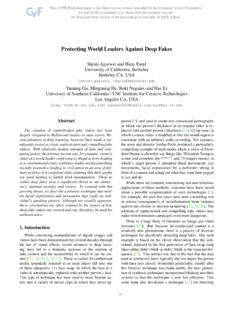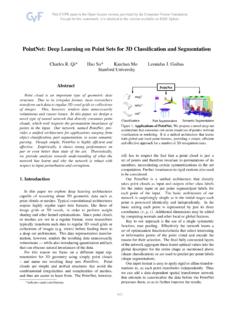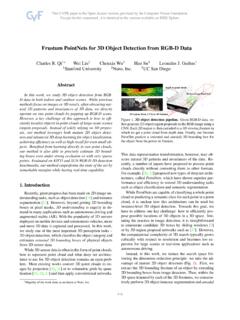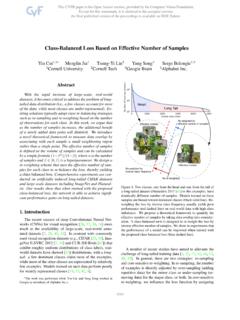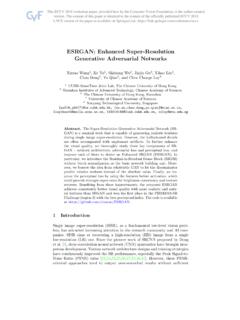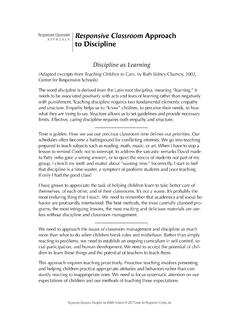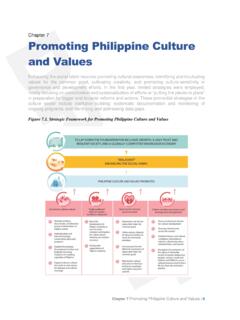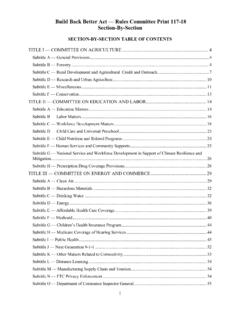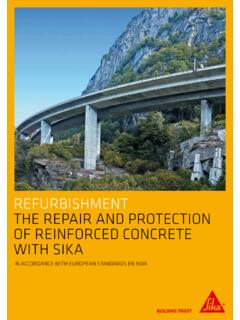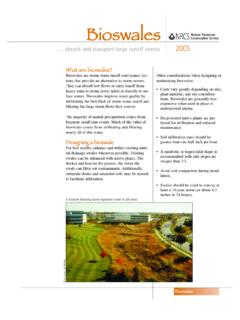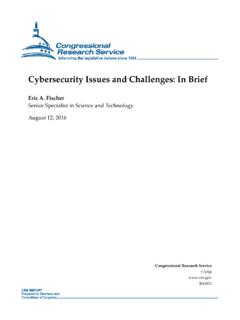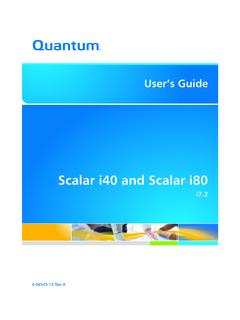Transcription of D-LinkNet: LinkNet With Pretrained Encoder and Dilated ...
1 D- LinkNet : LinkNet with Pretrained Encoder and Dilated Convolution for HighResolution Satellite Imagery Road ExtractionLichen Zhou, Chuang Zhang, Ming WuBeijing University of Posts and Telecommunications{zhoulichen, zhangchuang, extraction is a fundamental task in the field of re-mote sensing which has been a hot research topic in the pastdecade. In this paper, we propose a semantic segmentationneural network, named D- LinkNet , which adopts Encoder -decoder structure, Dilated convolution and Pretrained en-coder for road extraction task. The network is built withLinkNet architecture and has Dilated convolution layers inits center part. LinkNet architecture is efficient in computa-tion and memory. Dilation convolution is a powerful toolthat can enlarge the receptive field of feature points withoutreducing the resolution of the feature maps.}
2 In the CVPRDeepGlobe 2018 Road Extraction Challenge, our best IoUscores on the validation set and the test set are IntroductionRoad extraction from satellite images has been a hot re-search topic in the past decade. It has a wide range ofapplications such as automated crisis response, road mapupdating, city planning, geographic information updating,car navigations, etc. In the field of satellite image road ex-traction, a variety of methods have been proposed in recentyears. Most of these methods can be seperated into threecategories: generating pixel-level labeling of roads [1,2],detecting skeletons of roads [3,4] and a combination ofboth [5,6].In the DeepGlobe Road Extraction Challenge [7], thetask of road extraction from satellite images was formu-lated as a binary classification problem: to label each pixelas road or non-road.
3 In this paper, we handling the roadextraction task as a binary semantic segmentation task togenerate pixel-level labeling of roads,.Recently, deep convolutional neural networks(DCNN) [8,9,10,11] have shown their dominanceon many visual recognition tasks. In the field of im-age semantic segmentation, fully-convolutional network(FCN) [12] architecture, which can produce a segmentationmap for an entire input image through single forward pass,is prevalent. Most latest excellent semantic segmentationnetworks [13,14,15,16] are improved versions of previous works have applied deep learning toroad segmentation task. Mnih and Hinton [17] employedrestricted Boltzmann machines to segment road from highresolution aerial images.
4 Saitoet al. [18] used a classi-fication network to assign each patch extracted from thewhole image as road, building or background. Zhangetal. [1] followed the FCN architecture and employed a Unetwith residual connections to segment roads from one imagethrough single forward pass. In this paper, we follow thesemethods, using DCNN to handle road segmentation has been extensively studied in the past years,road segmentation from high resolution satellite images isstill a challenging task due to some special features of thetask. First, the input images are of high-resolution, so net-works for this task should have large receptive field that cancover the whole image. Second, roads in satellite imagesare often slender, complex and cover a small part of thewhole image.
5 In this case, preserving the detailed spacialinformation is significant. Third, roads have natural con-nectivity and long span. Taking these natural properties ofroads in consideration is necessary. Based on the challengesdiscussed above, we propose a semantic segmentation net-work, named D- LinkNet , which can properly handle uses LinkNet [15] with Pretrained Encoder asits backbone and has additional Dilated convolution layers inthe center part. LinkNet is an efficient semantic segmenta-tion neural network which takes the advantages of skip con-nections, residual blocks [10] and Encoder -decoder archi-tecture. The original LinkNet uses ResNet18 as its Encoder ,which is a pretty light but outperforming network. Linknethas shown high precision on several benchmarks [19,20],and it runs pretty convolution is a useful kernel to adjust recep-tive fields of feature points without decreasing the resolu-tion of feature maps.
6 It was widely used recently, and it1821 2 4 8 1 Conv[(1x1),(m/4, n)] Transposed-Conv[(3x3), (m/4,m/4), stride=2] Conv[(1x1),(m, m/4)] Max-Pooling Res-blocks n 3x3 Conv(dilation=n) 4x4 Transposed-Conv Skip connection Addition = Input Sigmoid output 3 * Res-blocks 4 * Res-blocks Conv[(7x7), stride=2] 6 * Res-blocks 3 * Res-blocks Conv(3x3) Conv(3x3) + Res-block 1024*1024*3 512*512*64 256*256*64 256*256*64 32*32*256 128*128*64 128*128*128 64*64*128 64*64*256 32*32*512 32*32*512 32*32*512 32*32*512 32*32*512 512*512*64 1024*1024*32 1024*1024*1 A B C Figure 1. D- LinkNet architecture. Each blue rectangular block represents a multi-channel features map. Part A is the Encoder of uses ResNet34 as Encoder . Part C is the decoder of D- LinkNet , it is set the same as LinkNet decoder.
7 Original LinkNet onlyhas Part A and Part C. D- LinkNet has an additional Part B which can enlarge the receptive field and as well as preserve the detailed spatialinformation. Each convolution layer is followed by a ReLU activation except the last convolution layer which use sigmoid has two types, cascade mode like [21] and paral-lel mode like [16], both modes have shown strong abilityto increase the segmentation accuracy. We take advatagesof both modes, using shortcut connection to combine thesetwo learning is a useful method that can directly im-prove network preformance in most situation [22], especiallwhen the training data is limited. In semantic segmantationfield, initializing encoders with ImageNet [23] pretrainedweights has shown promissing results [16,24].
8 In the DeepGlobe Road Extraction Challenge, our bestsingle model got IoU score of on the validation Network ArchitectureIn the DeepGlobe Road Extraction Challenge, the origi-nal size of the provided images and masks is1024 1024,and the roads in most images span the whole image. Still,roads have some natural properties such as connectivity,complexityet al. Considering these properties, D-LinkNetis designed to receive1024 1024images as input and pre-serve detailed spacial information. As shown in Figure1,D- LinkNet can be split in three parts A, B, C, named en-coder, center part and decoder uses ResNet34 [10] Pretrained on Ima-geNet [23] dataset as its Encoder . ResNet34 is originallydesigned for classification task on mid-resolution images ofsize256 256, but in this challenge, the task is to seg-ment roads from high-resolution satellite images of size1024 1024.
9 Considering the narrowness, connectivity,complexity and long span of roads, it is important to in-crease the receptive field of feature points in the center partof the network as well as keep the detailed pooling layers could multiply increase the receptivefield of feature points, but may reduce the resolution of cen-ter feature maps and drop spacial information. As shown bysome state-of-the-art deep learning models [21,25,26,16],1831 2 4 8 32*32*512 32*32*512 32*32*512 32*32*512 32*32*512 1 2 4 32*32*512 32*32*512 32*32*512 32*32*512 1 2 32*32*512 32*32*512 32*32*512 1 32*32*512 32*32*512 32*32*512 32*32*512 Figure 2. The center dilation part of D- LinkNet can be unrolled asthis structure. It contains Dilated convolution both in cascade modeand parallel mode, and the receptive field of each path is different,so the network can combine features from different scales.
10 Fromtop to bottom, the receptive fields are 31, 15, 7, 3, 1 convolution layer can be desirable alternative ofpooling layer. D- LinkNet uses several Dilated convolutionlayers with skip connections in the center convolution can be stacked in cascade mode. Asshown in the Figure1 of [21], if the dilation rates of thestacked Dilated convolution layers are 1, 2, 4, 8, 16 respec-tively, then the receptive field of each layer will be 3, 7, 15,31, 63. The Encoder part (RseNet34) has 5 downsamplinglayers, if an image of size1024 1024go through the en-coder part, the output feature map will be of size32 this case, D- LinkNet uses Dilated convolution layers withdilation rate of 1, 2, 4, 8 in the center part, so the featurepoints on the last center layer will see31 31points onthe first center feature map, covering main part of the firstcenter feature map.
